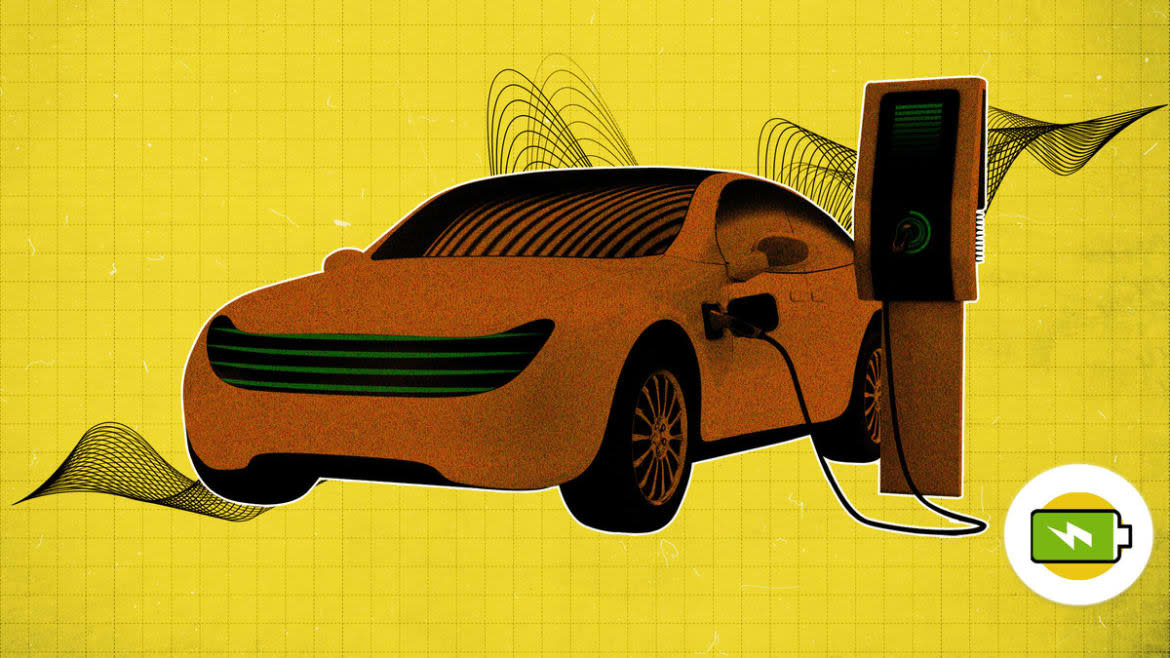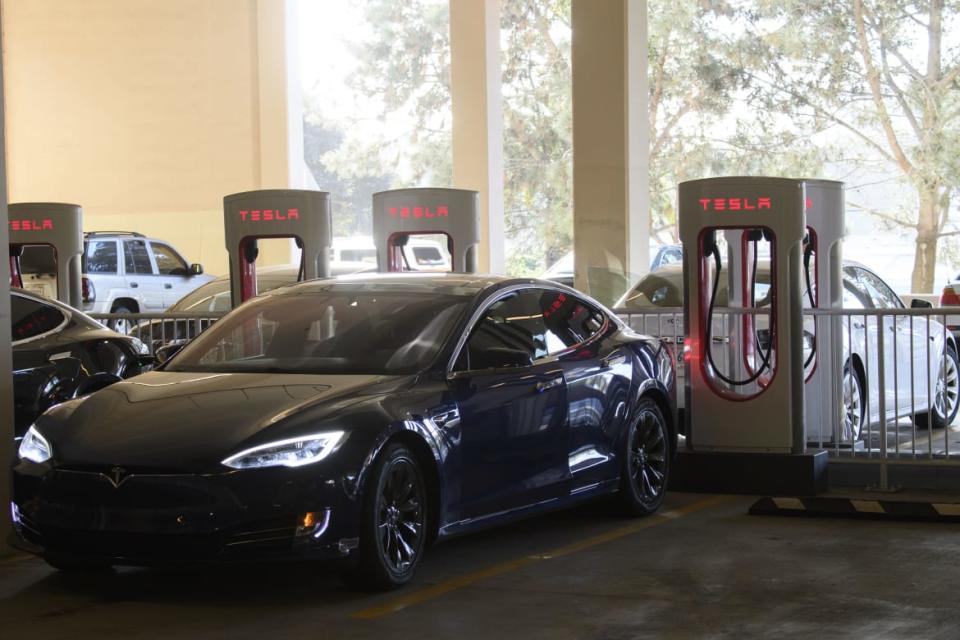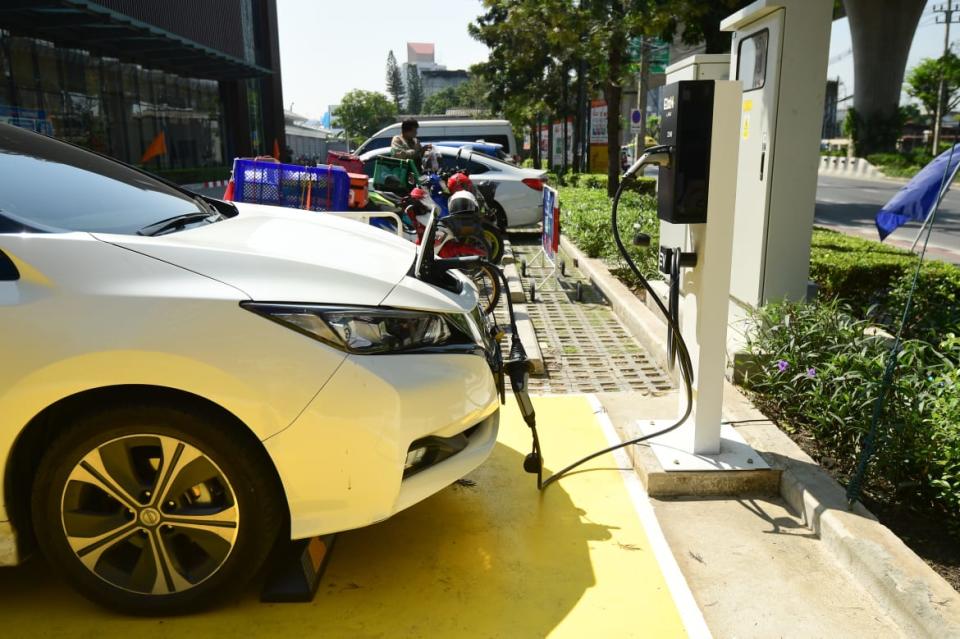The Last Big Obstacle to Electric Cars Is All in Your Mind

The average American drives fewer than 40 miles a day, well within the 200- to 300-mile range of most current-model electric cars. Yet electric cars still make up less than 5 percent of new motor vehicle sales. As EV technology has improved, range anxiety—the fear of running out of juice before you get where you’re going—has given way to anxiety about where you’re going to charge and how long it will take. And that may be holding people back from making the leap from gas to electric.
There’s no question that America needs more charging stations to accommodate the growth of electric vehicle sales and fuel the transition away from gasoline. If the escalating climate crisis hasn’t put a fine point on that, skyrocketing gas prices should. But it’s going to take more than infrastructure to wean Americans off the pump and get them hooked on electrons. We’ll need to reengineer the country’s car culture, learning to see the charging cord as a liberator not a tether, and changing some of our most ingrained travel habits outright.
“Right now the thinking is, ‘Build stations, we’ve got to build stations,’” John Eichberger, executive director of the Fuels Institute, a transportation energy research group, told The Daily Beast. “But once they’re built, how are we going to deal with human behavior?”
The Electric Car Battery of the Future Could Be Made From Trees
Leading the Charge
There are about 46,000 public chargers across the country, according to the Department of Energy’s latest count. The majority can give you 25 miles of range in about an hour. Fast chargers, numbering fewer than 6,000, can do it in 10 minutes or less. (These are rough estimates—it can vary a lot depending on the charger, the car, the state of the battery, and so on.) For comparison, there are around 150,000 gas stations in the U.S., most with several pumps, and all of which can fill ’er up in five minutes flat.
There are many parallel efforts to adequately wire the country. President Biden’s infrastructure plan puts $7.5 billion over five years toward building up America’s public charging network, with a goal of installing 500,000 chargers—many in disadvantaged and rural areas—and standardizing hardware and payment options to make it easier for anyone to charge anywhere. Charging companies are starting to collaborate even as they jockey for footprint, and a consortium of 50 utility companies is expanding their high-voltage connections to create a coast-to-coast fast-charging network along interstate highways.
Experts estimate that if we are to meet Biden’s target to make half of U.S. car sales electric by the end of the decade, the country needs between 100,000 and 1 million public fast chargers alone. BloombergNEF predicts EVs will make up only a quarter of sales by then—but even still, we’re running short.

A Tesla supercharger station in Redondo Beach, California.
Some people barely need public chargers. The roughly half of Americans who park in their own driveways or garages can plug in their cars when they get home each night and drive to work the next morning on a full charge. The cost is barely noticeable on their utility bill, about equivalent to running a refrigerator overnight.
For the other half of drivers, who don’t have reliable access to off-street parking, it’s more complicated. Some commuters might be able to charge up at work. Maybe your apartment complex or monthly lot has a few spots where you can plug in an EV. God help you if you need curbside charging in a dense city.
“In places like Manhattan, I know what a pain it is to find a parking spot,” Jeremy Michalek, a mechanical engineering professor and co-founder of the Vehicle Electrification Group at Carnegie Mellon University, told The Daily Beast. “If you add the constraint that some of those spots have chargers and some of them don’t, it just makes it even more of a nightmare.”
A Canadian company called Flo is trying to address urban shortages by installing charging plugs on street lamps. The company, which hosts tens of thousands of chargers north of the border, has installed 180 on street lights across Los Angeles. With a grant from the state energy commission, it is adding more in low-income communities.
Whether charging stations are needed to drive EV sales, or sales will impel new charging stations is seen as the industry’s central chicken and egg conundrum. But really, it’s a peanut butter and jelly problem, said Shazan Siddiqi, a technology analyst at market research firm IDTechEx. The two must go hand in hand.
Siddiqi holds up Tesla's strategy as the prime example of this dynamic. The top-selling electric vehicle company runs a global network of more than 30,000 public chargers, including nearly 6,000 across the U.S., and it’s planning to install 20,000 more each year. “They realized that the only way they can sell their cars is if they had that supporting infrastructure with it,” he told The Daily Beast. “They are leading by letting the world know that if you buy from us, you never have to worry about charging because we have plenty and they’re reliable, and they’re everywhere.”
Eichberger said it’s important for charging locations to place chargers front and center and advertise their whereabouts with unmissable signage. It’s not the current owners whose attention they need to grab—it’s the would-be buyers.
“It really is communicating to the non-EV drivers that EV charging exists,” he said. “If you buy an electric vehicle now, your car will tell you where all the charging locations are. If you are on the fence, are you going to feel comfortable buying an EV if you don't know where the chargers are?”
Breaking Old Habits
Infrastructure isn’t the only thing that needs to adapt to a post-gas future. We also need to rewire our brains.
After decades at the pump, the electrically uninitiated might imagine rolling into a service station at 2 percent and twiddling your thumbs while the battery icon creeps toward full. But rather than being a thing you go to a place to do, charging an electric vehicle is more likely to be a thing you do while you’re doing something else.
Most EV drivers do the bulk of their charging at home, and every few days “graze” at public ports while they’re at the mall or the supermarket. “They're not waiting three or four hours for their cars to reach 100 percent,” Siddiqi told The Daily Beast. “There is going to be this gradual shift from fully refueling your car to just topping up your car… when the opportunity comes up.”
Eichberger likens it to charging your smartphone: “You go to the airport and you’re at 60 percent, you’re looking for an outlet, right? That 60 percent is gonna last you, but you want that top-off,” he said. “We believe that most people, if there’s a charger available when they get to a location, they’re going to plug in.”

An electric vehicle charging station in front of a shopping mall in Bangkok.
If you can charge at home overnight and sip some electrons here and there as you go about your day, charging can be much more convenient than going to a gas station, and significantly cheaper, too. A PwC report estimates that people who drive an average of 10,000 miles a year spend at least $1,500 at the pump compared to around $300 for on-the-go charging.
Of course, things get a bit trickier on weekends away or an extended road trip. We’re used to driving until our tanks are empty and our bladders are full, then scouring road signs for a place to pull over. Winging it doesn’t fly when you’re behind the wheel of an electric car. EV owners need to plan ahead, mapping out charging stations near their route and within their battery’s range.
Naturally, there are apps for this. Tesla’s trip planner will automatically route you through its nationwide Supercharger network, complete with charging times. A cross-country drive from New York City to San Francisco in a Tesla Model 3 requires 19 charging stops of 10 to 55 minutes each. The same trip in a 2017 Honda Civic would take half as many fill ups and probably cost one-and-a-half times as much.
Whether EV drivers need to keep themselves busy for 10 minutes or an hour, it behooves charge providers to give them a place to kill time, get on Wi-Fi and spend those sweet, sweet fuel savings. That’s why this year ChargePoint, the largest network of charging stations in North America, is putting chargers outside 15 Starbucks locations on the 1,350-mile stretch from Seattle to Denver. Electrify America puts many of their chargers in Walmart parking lots and is designing elevated, “human centered” charging lounges for standalone stations and valet charging at California shopping centers.
This Freeze-Resistant Battery Can Boost Renewable Energy Use
As electric charging winds its way into the mainstream, our fueling habits will have to keep adapting. What’s the protocol if you plug in at a public spot before dinner and a movie, but your battery is full before they fire the entrees? Should you move your car to let someone else juice up? Can a stranger unplug your car to plug theirs in? What if someone has been hogging one of the two EV spots in your building’s garage for a week?
Michalek, the CMU professor, thinks technology could play a role and imagines the possibilities of combining wireless charging and autonomous driving. “It could be that some cars are able to navigate themselves to a charger overnight and then just come back,” like road Roombas, he suggested.
But there are other problems that tech probably won’t solve. Like holiday weekends. Peak travel days could create hours-long lines at charging stations, or blow out the grid. “One thing I wonder is, are we going to keep doing all of our long-distance travel on the same holidays?” Michelek asked. “Is the public capable or interested in shifting their travel behavior?”
No matter what, we will need to set new social norms around electric vehicles, Eichberger said. “It comes down to how society can evolve.”
Get the Daily Beast's biggest scoops and scandals delivered right to your inbox. Sign up now.
Stay informed and gain unlimited access to the Daily Beast's unmatched reporting. Subscribe now.

